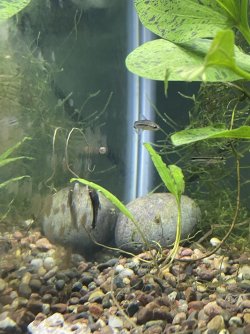So last month I got 6 pygmy cories to add to my 20gal community tank (relevant threads) with platies, zebra danios, and cherry shrimp. I really loved seeing them school at first. But, I don't think they're doing very well. Of the 6 I bought, 2 were unhealthy and died after a day or two. Another one I later had to euthanize because it was injured to the point that it couldn't swim (I think I might've hurt it while moving decorations around).
Of the 3 I have left (which I'm sure are stressed), one of them (always the biggest) is still healthy, but the other two spend most of their time laying on the substrate, and also seem to be missing the lower fork of their tail fin? I'm not sure if this is from fin-nipping at the store or if my gravel is hurting them. I'm also having difficulties feeding them, since they're so much smaller than the other fish, and don't have safety in numbers to feel safe eating alongside the larger fish.
My intention, at first, was to get more as soon as I can (although I haven't had the money to yet), thinking that once they feel safe in a school they will be more healthy and confident. But I'm starting to feel like the species in general is just too small and fragile to fit in with the rest of my tank. I'm also starting to feel disappointed with the appearance of the fish, although that might just be because I'm not seeing them school anymore.
I'm starting to wonder if I should try to take them back and get another species (like sterbai or julii) instead. When I was initially shopping I felt like these were too big (and still do a little) but I've also realized that they would be juvenile when I bought them, and by the time they were fully grown my platies might also be a lot bigger. I also like the coloration of those species better. My only concern though is that a larger species will leave less room in the tank stocking-wise, as I would also like to eventually add a panda garra at some point and that is also a larger fish.
I'm not sure what route I should choose. On one hand I feel like the sterbai/julii would be safer and more visually appealing in the tank, but on the other hand, I feel like all this might be better if I can just fix the situation with the pygmies, since I didn't feel this way before I was having trouble with them.
Of the 3 I have left (which I'm sure are stressed), one of them (always the biggest) is still healthy, but the other two spend most of their time laying on the substrate, and also seem to be missing the lower fork of their tail fin? I'm not sure if this is from fin-nipping at the store or if my gravel is hurting them. I'm also having difficulties feeding them, since they're so much smaller than the other fish, and don't have safety in numbers to feel safe eating alongside the larger fish.
My intention, at first, was to get more as soon as I can (although I haven't had the money to yet), thinking that once they feel safe in a school they will be more healthy and confident. But I'm starting to feel like the species in general is just too small and fragile to fit in with the rest of my tank. I'm also starting to feel disappointed with the appearance of the fish, although that might just be because I'm not seeing them school anymore.
I'm starting to wonder if I should try to take them back and get another species (like sterbai or julii) instead. When I was initially shopping I felt like these were too big (and still do a little) but I've also realized that they would be juvenile when I bought them, and by the time they were fully grown my platies might also be a lot bigger. I also like the coloration of those species better. My only concern though is that a larger species will leave less room in the tank stocking-wise, as I would also like to eventually add a panda garra at some point and that is also a larger fish.
I'm not sure what route I should choose. On one hand I feel like the sterbai/julii would be safer and more visually appealing in the tank, but on the other hand, I feel like all this might be better if I can just fix the situation with the pygmies, since I didn't feel this way before I was having trouble with them.




